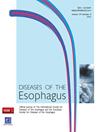790.印度东北部食管癌的危险因素:一项多中心病例对照研究
IF 2.3
3区 医学
Q3 GASTROENTEROLOGY & HEPATOLOGY
引用次数: 0
摘要
背景 印度东北部食管癌发病率很高,经年龄调整后,每 10 万人中女性和男性的发病率分别为 19 至 50 例。这是印度食道癌平均发病率的十倍以上。生槟榔的当地制剂 "kwai "是槟榔文化中不可或缺的一部分,但其作用尚未确定。本研究旨在评估槟榔(含或不含烟草)作为诱发心血管疾病的因素的作用。此外,还研究了酒精的作用。方法 从 2022 年 10 月到 2024 年 3 月,在印度东北部地区的三个中心开展了一项多中心、匹配病例对照研究。研究纳入了所有经活检证实的环咽部至胃食管交界处鳞状EC病例,配对对照(比例为1:3)为因轻微疾病到医院就诊的患者和来自社区的健康志愿者。经过培训的试验协调员负责发放经过验证的调查问卷。数据分析采用条件多元逻辑回归法,将病例与 3 个对照组进行单独匹配。P值为<0.05即为具有统计学意义。结果 共有 185 个病例和 556 个对照组进行了年龄(± 5 岁)、种族和性别匹配。食用含消石灰[氢氧化钙 Ca(OH)2] 的槟榔、酒精(OR 2.00 CI:1.80-6.67)和烟草(OR 3.47 CI:1.80-6.67)的人群罹患心肌梗死的风险增加(Odds Ratio(OR)为 3.77(置信区间(CI)为 1.30-10.92))。与吐出槟榔的人相比,吞咽槟榔和果汁的人风险更高(OR 4.01 CI:2.24-6.73)。饥饿时而非进餐时食用槟榔的风险更高(OR 10.40 CI 3.66-29.57)。未受过正规教育的人群的风险更高(OR 为 4.13 CI:2.01-8.49)。在对其他风险因素(烟草和酒精)进行调整后,槟榔与烟草(OR 7.84 CI 2.12-29.90)和槟榔与酒精(OR 2.84 CI 1.11-7.29)的风险最高。所有这些OR值均具有统计学意义。结论 食用槟榔和熟石灰会增加罹患心血管疾病的风险。同时吸烟和饮酒也会增加感染心血管疾病的风险。本文章由计算机程序翻译,如有差异,请以英文原文为准。
790. RISK FACTORS FOR ESOPHAGEAL CANCER IN NORTHEAST INDIA: A MULTI-CENTRIC CASE-CONTROL STUDY
Background Northeast India has a high incidence of esophageal cancer(EC), with age-adjusted incidences ranging from 19 to 50 per 100,000 (in females and males respectively). This is over ten times the average incidence of EC in India. The local preparation of raw betel nut,‘kwai’, is integral to the culture, but its role has not been established. This study aimed to assess the role of betel nut, with or without tobacco as a causative agent for EC. The role of alcohol was also studied. Methods A multi-centric, matched case-control study was performed from October 2022 to March 2024 in three centres situated in the Northeast region of India. All cases of biopsy proven squamous EC, arising from the cricopharynx to the gastroesophageal junction were included, with matched controls (1:3 ratio) being patients visiting the hospital for minor ailments and healthy volunteers from the community. A validated questionnaire was administered by trained trial coordinators. The data was analysed using a conditional multivariate logistic regression which incorporated the individual matching of cases with 3 controls. A p-value of < 0.05 was considered statistically significant. Results A total of 185 cases and 556 controls were matched for age (± 5 years), ethnicity, and gender. There was an increased risk of EC for those consuming betelnut with slaked lime [Calcium hydroxide Ca(OH)2] (Odds Ratio(OR) of 3.77 (Confidence Interval(CI) 1.30-10.92)); alcohol (OR 2.00 CI: 1.80-6.67) and tobacco (OR 3.47 CI:1.80-6.67). The risk was higher for those who swallowed the betel quid and juice as compared with those who spit it out (OR 4.01 CI: 2.24-6.73). The risk was increased in those consuming betelnut while hungry, instead of a meal (OR 10.40 CI 3.66-29.57). The risk was increased in those with no formal education (OR of 4.13 CI: 2.01-8.49). On adjusting with other risk factors (tobacco and alcohol), the risk was highest for betelnut with tobacco (OR 7.84 CI 2.12-29.90) and betelnut with alcohol (OR 2.84 CI 1.11-7.29). All these OR were statistically significant. Conclusion Consumption of betelnut with slaked lime increases the risk of EC. This risk is increased by the concomitant use of tobacco and alcohol.
求助全文
通过发布文献求助,成功后即可免费获取论文全文。
去求助
来源期刊

Diseases of the Esophagus
医学-胃肠肝病学
CiteScore
5.30
自引率
7.70%
发文量
568
审稿时长
6 months
期刊介绍:
Diseases of the Esophagus covers all aspects of the esophagus - etiology, investigation and diagnosis, and both medical and surgical treatment.
 求助内容:
求助内容: 应助结果提醒方式:
应助结果提醒方式:


